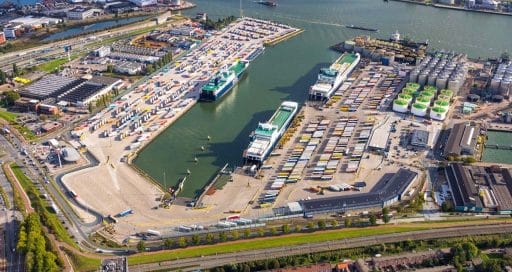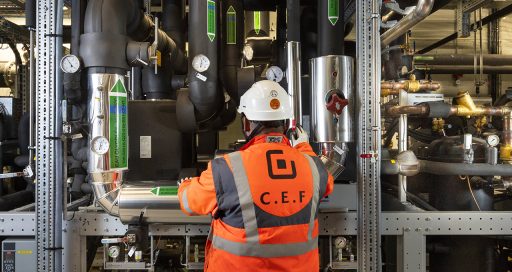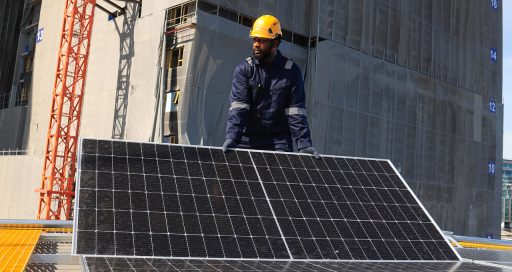In order to significantly reduce greenhouse gas emissions from ships, dockside electrical supplies will become the standard by 2030. Onshore Power Supply is a more environmentally friendly electricity supply solution. Several VINCI Energies business units are working on this topic across Europe.

While docked, ships use their auxiliary engines, which typically run on diesel fuel, to generate electricity. This is not only noisy and smelly, but also produces significant greenhouse gas emissions. Given that 74 percent of European imports and exports are transported by sea, the environmental impact of this practice is considerable. That is why the European regulation stipulates that “From 1 January 2030, a ship at berth in a port of call under the jurisdiction of a Member State shall connect to on-shore power supply and use it for all energy needs while at berth.”
A dockside electrical supply, known as “Onshore Power Supply (OPS)”, allows ships to draw electricity from the local grid and thus avoid using their onboard diesel generator. Of course, this technology is all the more virtuous in ecological terms where the local grid provides low-carbon energy.
“We design, build and install customised OPS systems. These are compact systems that are easy to use from aboard a ship.”
Technically speaking, an OPS system is composed of a substation that receives and distributes electricity from the grid, a frequency converter to provide the required frequency (60 Hz for ships as opposed to 50 Hz for shore side electrical networks) and a cable management system to transfer the electricity cable from the dockside to the ship.
With this type of installation, the reduction in emissions can be in the order of 70% for CO2, 95% for NOx (Nitrogen Oxides) and 30% for SOx (Sulphur Oxides). This therefore offers real benefits in terms of accelerating environmental transition.
Numerous projects in Spain
Through its Actemium brand and pioneering Swedish business units in this field (see box), VINCI Energies has been developing this technology for a decade in several European countries. In Spain, 119,200 ships transited the country’s ports in 2022, and the port authorities are actively engaged in dockside electrification projects.
“In some cases, these developments are fairly advanced, such as in Barcelona and Alicante, or even finished, like at the Port of Palma in the Balearic Islands. Other sites are in the process of submitting construction plans; these include Huelva, Bahía de Algeciras and Bilbao. Others are in the feasibility study phase, such as the Malaga Port Authority and Port of Castellón,” says Alejandro Garcia, Director of Hydrogen and Ports at VINCI Energies Spain and a specialist in OPS systems. All Spanish ports will eventually follow suit, beginning with the 46 public-interest ports managed by the government.
Rotterdam: the pioneer
Undoubtedly one of Europe’s most advanced ports in this area is Rotterdam, in the Netherlands. Europe’s largest port has already completed several dockside power supply projects and is planning to add between eight and ten new installations by 2025. In October 2022, as part of this project, Actemium Nederland secured an EPC (Engineering Procurement and Construction) contract to implement an OPS solution at the DFDS terminal in Vlaardingen. With a capacity of 1.8 MW, enough to power almost 1,500 homes, the system will supply 3.5 GWh of electricity per year. This investment should make it possible to reduce annual CO2 emissions by around 2,100 tonnes.
“Large international ocean-going vessels have particular electricity needs,” explains Johan de Goffau, Business Development Manager at Actemium Nederland. “They need a power supply between 500 and 2,000 kW, which is comparable to the needs of a small business. That’s why we design, build and install customised OPS systems. These are compact systems that are easy to be operated from aboard a ship. An OPS system is generally installed in a container and so in principle, is mobile. In practice, however, the system tends to be installed in a specific place near where the ships are berthed.”
Specific constraints
The VINCI Energies business unit has had to adapt to some specific constraints. “We had to find an articulated arm system that could connect the ships regardless of their mooring configuration. Another challenge is to carry out our civil engineering works without disrupting the port’s operations. We adapt to the customer’s schedule and shipping company timetables to avoid disrupting traffic,” says Johan de Goffau.
With Actemium’s international network, and its Swedish subsidiary in particular, having considerable expertise in designing and building OPS systems, Actemium Nederland hopes to extend this technology to other Dutch and Belgian ports such as Amsterdam, Antwerp, Ghent, Terneuzen and Vlissingen. “Because Actemium often works for businesses in the energy sector and petrochemical industry, we have extensive experience of explosion-sensitive environments and can meet the enhanced safety requirements that apply to oil tankers, for example,” concludes Johan de Goffau.
Actemium brings electricity to oil tankers in ATEX area in the Port of Gothenburg
In 2000, the Port of Gothenburg was the first to offer onshore power supply to ships. By the end of 2023, the Swedish port will have achieved another world first by also allowing oil tankers to make electrical connections in ATEX area. This is a challenge given the constraints related to the dangerous environments (due to their explosive potential) in ports that receive oil tankers.
Having previously installed an OPS system in the RoRo terminal that specialises in handling cars, Actemium Sweden is responsible for scheduling, delivering, assembling, connecting and adjusting the installation. It takes the form of three 20-foot containers to be permanently installed dockside.
To make them safe for ships to use, these containers were specially designed using new technological solutions. “The cable drum, which is typically installed on the outside of the container, is here installed inside. This to avoid mixture of potentially explosive gases to get in contact with the high voltage equipment used to energise the ship. We “over pressurise” the equipment and continuously inject fresh air taken at least 100 meters away away from the connection point as a safety precaution,” says André Olofsson, OPS Project Manager at Actemium Sweden. Among the 24 OPS projects that the VINCI Energies subsidiary has already implemented since 2010, according to André Olofsson, “This project in Gothenburg is the most technically challenging with the ATEX area in mind and flexible connection equipment.”
16/06/2023





